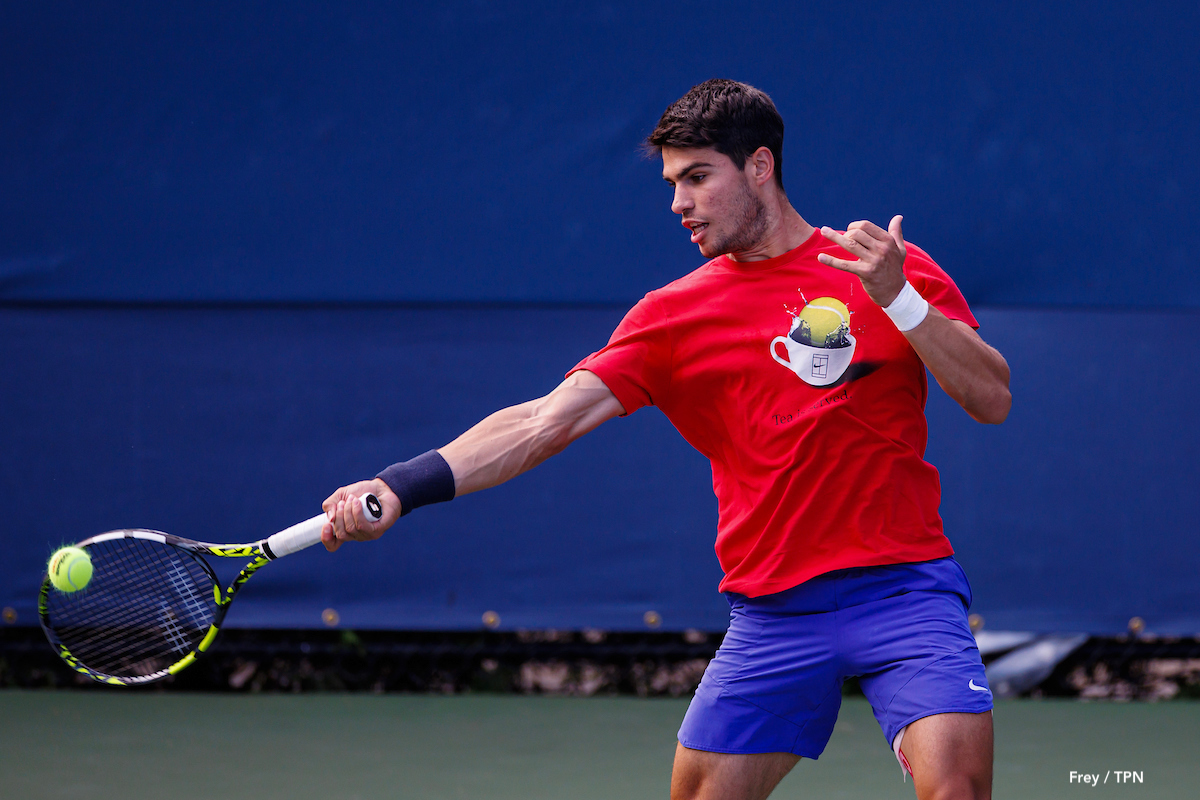G’day from New York,
Carlos Alcaraz wants everyone to believe that all is good in his world coming into the 2023 US Open, where he is the defending champion.
He has actually gone a step further by announcing in a pre-tournament press conference that he has improved since taking the title last year.
“I feel that I am more mature on the court. I feel that I am a better player than I was a year ago. I got my first Grand Slam last year, but I feel like I am more mature and better,” Alcaraz said in an interview this week.
I don’t buy it.
On one hand, Alcaraz is 56-3 this season and has a tour-leading six titles. Almost unstoppable.
On the other hand, his return of serve has recently started bleeding errors – particularly his forehand return. I wrote an ATP analysis of the Cincinnati final, where Alcaraz held a match point but lost to Novak Djokovic 5-7, 7-6(7), 7-6(4). One of the keys of the match was the surprising total of return errors from the match.
2023 Cincinnati Final: Return Errors
- Djokovic = 18
- Alcaraz = 37
The number of return errors, particularly in big moments, showed Alcaraz was definitely struggling with this part of his game. In particular, the struggle started in Toronto and grew in Cincinnati. This part of his game needs to get fixed fast if he is to repeat as champion in New York.
Let’s dig into the numbers and compare his return performance from the following nine tournaments this year.
Tournament / Result
- Indian Wells = Won
- Miami = Semi-Finals
- Barcelona = Won
- Madrid = Won
- Roland Garros = Finalist
- Queens = Won
- Wimbledon = Won
- Toronto = Qtr Finals
- Cincinnati = Finalist
RETURNS MADE
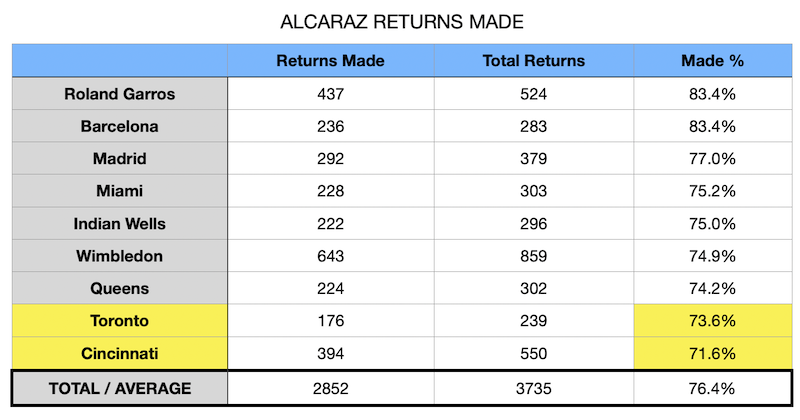
The carnage on the return side of the game is clearly evident in Toronto and Cincinnati, which feature at the bottom of the Returns Made table.
Alcaraz only put 71.6% (394/550) of his returns in play in Cincinnati. These are clearly not a player’s numbers at the top of his game. He was stronger in this area on hard courts in both Miami and Indian Wells earlier this season.
When you break the data down further, you see the forehand return suffering the most.
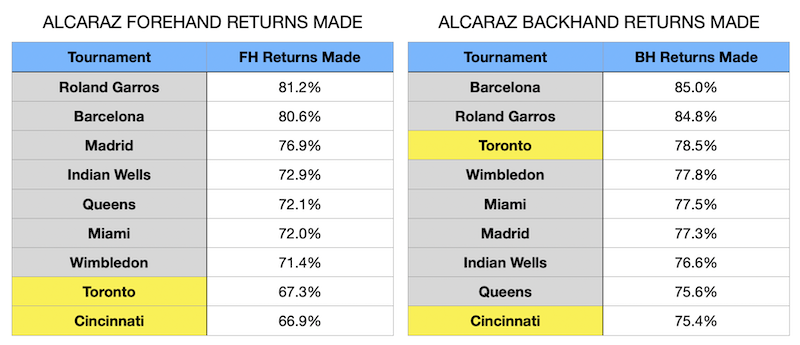
Forehand return performance was at its lowest point from these nine events in Cincinnati (66.9%). Backhand return performance was also weakest in Cincinnati (75.4%) but performed well in Toronto (78.5%).
Watch the short video below to understand the return errors vs. Djokovic in the Cincinnati final.
2023 Cincinnati Final: Alcaraz Return Errors vs. Novak Djokovic (TennisTV)
RETURNS WON
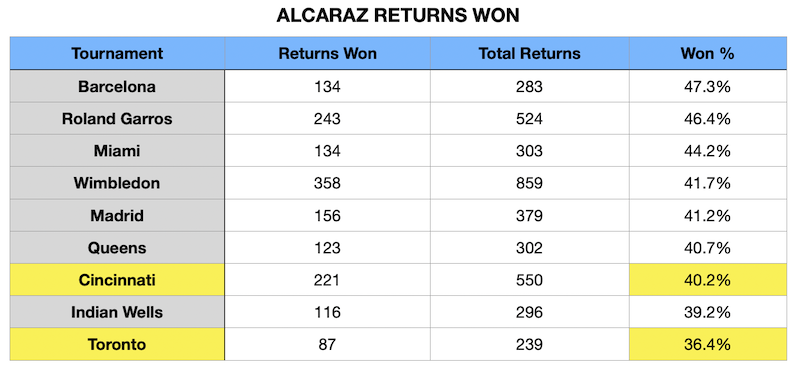
Toronto drops to the bottom of the table with Returns Won at just 36.4% (87/239). That’s a long way off Alcaraz’s stellar performance at Barcelona (47.3% won) and also on hard courts in Miami with 44.2% won. It will be impossible for him to win the US Open if he puts up Toront0-type numbers in New York.
Let’s look at a breakdown of forehand and backhand return points won.
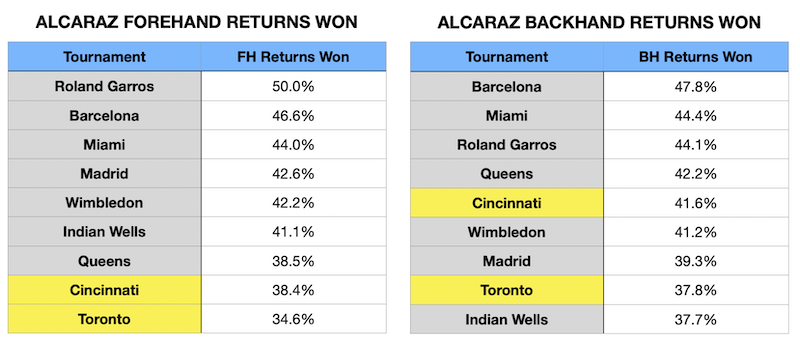
It’s the forehand return. It’s the forehand return.
Alcaraz’s forehand return is the weakest out of all nine tournaments in Toronto (34.6% won) and Cincinnati (38.4% won). The backhand return performed okay in Cincinnati but came in eighth place in Toronto.
So, what exactly is wrong with Alcaraz’s forehand return?
The answer is two parts.
The first is that he has lost confidence in where to stand. He is all over the spectrum with his return location, hurting his rhythm, timing, and spacing to the ball. He is jammed a lot. Look at the pic below from the Cincinnati final vs. Djokovic. That’s not normal return positioning on a hard court.
Hawk-Eye Graphic: Alcaraz Return Hit Points vs. Djokovic 2023 Cincinnati Final
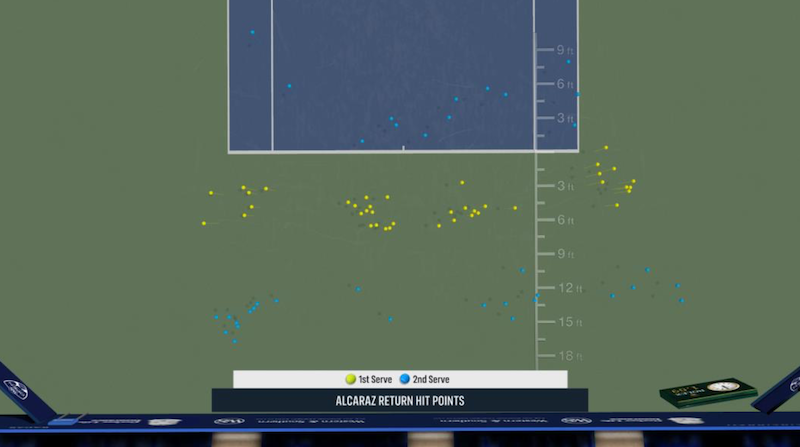
Some blue dots are 16 feet behind the baseline, while one doesn’t even register on the scale because it is so far forward, probably around 10 feet inside the baseline. To simplify things, he is either too far back or too far in vs. 2nd serves and has become the master of neither.
The second part can be seen from the video. He is often going too steep up the back of the ball and mishitting it. Too much attempted spin trying to get the ball in play, or too much power blasting the ball wildly. He started the Cincinnati final with a forehand return error, and also finished the match with the exact same error.
For the next two weeks in New York, he needs to stop bouncing around so much with his return position and settle into a spot where he can put a lot of returns back in play. He needs to return to his roots and hit through the return rather than “cuffing” it so much. Forget the return winners (for a while) and reduce the return errors.
Looking forward to seeing the adjustments!
Craig

